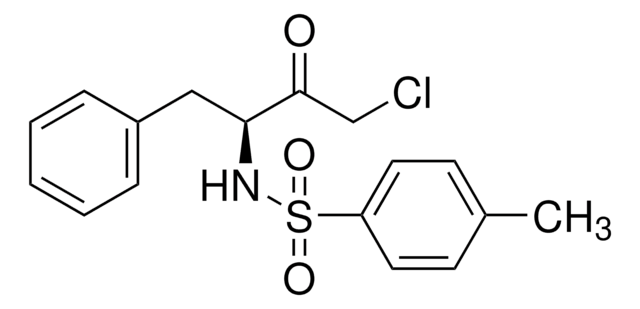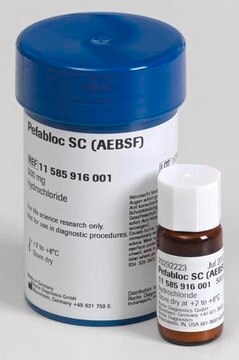52332
Phenylmethylsulfonyl Fluoride
Phenylmethylsulfonyl Fluoride, CAS 329-98-6, is an irreversible inhibitor of serine proteases. It causes sulfonylation of the active-site serine residues.
Sinônimo(s):
Phenylmethylsulfonyl Fluoride, Benzylsulfonyl Fluoride, PMSF
About This Item
Produtos recomendados
Nível de qualidade
descrição
RTECS - XT8040000
Ensaio
≥99% (GC)
Formulário
crystalline solid
fabricante/nome comercial
Calbiochem®
condição de armazenamento
OK to freeze
desiccated
cor
white to off-white
solubilidade
ethanol: soluble
isopropanol: soluble
methanol: soluble
Condições de expedição
ambient
temperatura de armazenamento
10-30°C
cadeia de caracteres SMILES
F[S](=O)(=O)Cc1ccccc1
InChI
1S/C7H7FO2S/c8-11(9,10)6-7-4-2-1-3-5-7/h1-5H,6H2
chave InChI
YBYRMVIVWMBXKQ-UHFFFAOYSA-N
Descrição geral
Ações bioquímicas/fisiológicas
serine proteases
Advertência
Reconstituição
Outras notas
Weaver, V.M., et al. 1993. Biochem. Cell. Biol.71, 488.
Bourgain, R.H., et al. 1992. Adv. Exp. Med. Biol.316, 427.
Chang, C.T., et al. 1992. Biochem. Int.28, 707.
Informações legais
Palavra indicadora
Danger
Frases de perigo
Declarações de precaução
Classificações de perigo
Acute Tox. 3 Oral - Skin Corr. 1B
Código de classe de armazenamento
6.1A - Combustible acute toxic Cat. 1 and 2 / very toxic hazardous materials
Classe de risco de água (WGK)
WGK 3
Ponto de fulgor (°F)
Not applicable
Ponto de fulgor (°C)
Not applicable
Certificados de análise (COA)
Busque Certificados de análise (COA) digitando o Número do Lote do produto. Os números de lote e remessa podem ser encontrados no rótulo de um produto após a palavra “Lot” ou “Batch”.
Já possui este produto?
Encontre a documentação dos produtos que você adquiriu recentemente na biblioteca de documentos.
Os clientes também visualizaram
Nossa equipe de cientistas tem experiência em todas as áreas de pesquisa, incluindo Life Sciences, ciência de materiais, síntese química, cromatografia, química analítica e muitas outras.
Entre em contato com a assistência técnica











